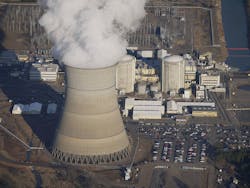Many consider nuclear energy to be clean energy, since it has a small carbon footprint relative to the amount of energy it produces. But others point to its perceived inherent dangers.
When the American Clean Energy and Security Act of 2009 – known as the Waxman-Markey Bill and generally regarded as the first energy and climate change bill – was being debated in Congress, nuclear power proponents argued that, because nuclear energy is a low emissions power source, it should receive the same incentives as recognized renewable energy sources, such as solar, wind, hydro, and geothermal.
Opponents argued then and now that, although it is clean (if we define clean as low carbon), it is not renewable. Why? Because it depends on uranium, of which there is a finite amount on Earth. Perhaps one of the most persuasive arguments to classify nuclear energy as "renewable" came in a 1983 note from Bernard Cohen, Professor Emeritus of Physics at the University of Pittsburgh. (He died in 2012.)
In introducing that note, published in the American Journal of Physics, Prof. Cohen wrote, “Since energy sources derived from the Sun are called 'renewable,' that adjective apparently means that they will be available in undiminished quantity at present costs for as long as the current relationship between the Sun and Earth persists, about 5 billion years. It is the purpose of this note to show that breeder reactors using nuclear fission fulfill this definition of a renewable energy source, and in fact can supply all the world’s energy needs at present costs for that time period.”
Insofar as I could find, only one state, Utah, has determined by legislative fiat that nuclear energy is renewable. In the same year as Waxman-Markey (2009), the Utah legislature passed, and the governor signed, H.B. 430 Economic Development Incentives for Alternative Energy Projects.
Of course, even if we accept Prof. Cohen’s thesis, that nuclear energy is both clean and renewable, there is still an elephant in the room: WASTE. Namely, what do we do with it? Waste, from both power plants and other nuclear facilities, includes some that will remain dangerously radioactive hundreds of thousands of years into the future. For example, Plutonium-239 has a half-life of 24,000 years! Technetium-99 has a half-life of 220,000 years, and Iodine-129 has a half-life of 15.7 million years!
According to the International Atomic Energy Agency estimates, 50 countries will have nuclear reactors by 2030, with nearly one thousand reactors worldwide in the next 20 years.
That nuclear waste is not just from power plants, there are also research labs, hospitals, and weapons-related facilities that contribute to the problem. Perhaps the best (or worst) example is the Hanford Site, formerly the Hanford Engineer Works and then the Hanford Nuclear Reservation. This facility produced plutonium for the Manhattan Project during WWII, some of which was used in the atomic bomb dropped on Nagasaki in 1945. There was more than 56 million gallons of radioactive, toxic wastewater left behind and that site is arguably still the most polluted location in our hemisphere, 75 years later.
So, let the pundits and politicians debate whether nuclear energy is really renewable. Solar PV sounds like the greener solution to me.
###########
A regular contributor to HPAC Engineering and a member of its editorial advisory board, the author is a principal at Sustainable Performance Solutions LLC, a south Florida-based engineering firm focusing on energy and sustainability. Contact him at [email protected].
About the Author
Larry Clark
A member of HPAC Engineering’s Editorial Advisory Board, Lawrence (Larry) Clark, QCxP, GGP, LEED AP+, is principal of Sustainable Performance Solutions LLC, a South Florida-based engineering firm focused on energy and sustainability consulting. He has more than two dozen published articles on HVAC- and energy-related topics to his credit and frequently lectures on green-building best practices, central-energy-plant optimization, and demand-controlled ventilation.
